Chapter 12 Mexican-American Opiate Addicts
| Books - Epidemiology of Opiate Addiction in United States |
Drug Abuse
The Epidemiology of Opiate Addiction in the United States
Chapter 12
Mexican-American Opiate Addicts
CARL D. CHAMBERS, WALTER R. CUSKEY, AND ARTHUR D. MOFFETT
Introduction
Various empirical studies have established the necessity for considering sex, race, culture, and geographic region of residence when describing any addict population. Empirical descriptions are available in the literature of Negro addicts,' Puerto Rican addicts,2 Chinese addicts,3 Southern addicts,' and of the general addicted' population in various sex, race, and cultural group comparisons.5 Noticeably absent, however, is any definitive description of the Mexican-American opiate addicts.
Among the six distinct ethnic and cultural groups making up the addicted population in the United States, Mexican-Americans are the fourth largest contributor.6 Among the contemporary addicts the Mexican-Americans are more overrepresented than any other group except the Puerto Ricans who reside within the United States.' In spite of their prevalence within the addicted population, no meaningful empirical study has been accomplished with this specific group. This study was designed to alleviate this gap in our literature.
Research Design
The study was designed to provide empirical data relevant to three specific areas of inquiry: to describe the contemporary Mexican-American addicts, to describe the recent changes, if any had occurred, within the Mexican-American addict population, and to compare the Mexican-American addicts with their contemporaries from other ethnic-cultural groups. To accomplish these inquiries, data were analyzed for all admissions to the Lexington and Fort Worth hospitals during the first six months of 1961 and 1967.
During the first six months of 1961, there were 1,745 addicts admitted to either Lexington or Fort Worth. Of these, 102, or 5.8 percent, were Mexican American. During the same six months of 1967, 1,438 addicts were admitted to the two hospitals, with 169, or 11.8 percent, being Mexican-Americans.' All statistical comparisons and descriptions were accomplished with these two populations.
For the purposes of description and comparison, the attributes available for analysis were grouped into three categories: ( a ) social characteristics, ( b ) characteristics associated with addiction and related deviancies, and ( c ) hospital admission characteristics. Wherever possible and whenever appropriate, the sex of the addicts was treated as an independent variable.
Of the 102 Mexican-American addicts admitted during the 1961 sample period, 14, or 13.7 percent, were females. During the 1967 period only 10, or 5.9 percent, of the 169 Mexican Americans admitted for treatment were female addicts. It was apparent, therefore, that while the incidence of Mexican-American addicts had doubled among all of the admissions, this increase was among male addicts only.

Social Characteristics
Residence
The majority of Mexican-American addicts admitted during 1961 had resided in one of three states: California, Texas, or New Mexico. These three southwestern areas contributed 69.6 percent of all of the Mexican-American addicts. There were, however, significant sex differences in the number of patients from these three states. California contributed 31.8 percent ( N=28 ) of all the male addicts and 21.4 percent ( N=3 ) of all the female addicts.-Texas contributed 27.3 percent (N=24) of the male addicts and 21.4 percent ( N=3 ) of the female addicts. Finally, New Mexico contributed 13.6 percent ( N=12 ) of the male addicts but only 7.1 percent ( N=1) of the female addicts. The remaining twenty-four male addicts were distributed as follows: nine from Arizona, four from Illinois, three from Colorado, and eight from other states. Of the remaining seven female addicts, one came from Arizona, two from Illinois, two from Colorado, and two from other states.
The number of addicts admitted from California, Texas, and New Mexico increased significantly in 1967 to 92.2 percent of all Mexican American admissions.' The distribution of admissions from these states also changed. California, the largest contributor in 1961, contributed proportionately only half as many addicts in 1967. Texas, on the other hand, doubled its contribution, and the incidence for New Mexico remained approximately the same.
During this latter period Texas contributed 61.0 percent ( N= 97 ) of the males and 60.9 percent ( N=6 ) of the females, replacingCalifornia as the largest contributor of addicts of both sexes. California contributed19.5 percent ( N=31) of the male addicts andnone of the female addicts. New Mexico contributed13.8 percent ( N=22) of the male addicts andnone of the female addicts. Of the remaining nine male addicts three came from Arizona, two from Illinois, one from Colorado, and three from other areas. Three female addicts were from Illinois and one from Colorado. Thus, in1967 Texas replaced California as the largest contributor of addicts of both sexes, andthe significant increase in the incidence of Mexican-American addicts at the two hospitals is due primarily to the increase among males residing in Texas.
Religious Background
As would be expected, the majority of Mexican-American addicts had been reared in Catholic homes. In1961 93.0 percent of the addicts reported themselves as being Catholics, as did94.7 percent in1967.

Level of Formal Education
Most Mexican-American addicts, regardless of their sex, have been school dropouts. In1961 88.2 percent of the addicts were dropouts, as were87.0 percent of the addicts admitted during1967. This high incidence of school dropouts is in contrast to other addict groups."'
The distribution of attained formal education did not change significantly between1961 and1967. This was true regardless of the sex of the addict. Several findings do, however, require some elaboration:
1. Female addicts frequently have formal education beyond high school. In1961 none of the female addicts had pursued higher education. By1967 10.0 percent of all the female addicts were found to have gone beyond high school.
2. The number of female addicts who had dropped out of school before completing high school decreased between1961 and1967. While92.9 percent of the females were dropouts in1961, 80.0 percent dropped out in1967.
Marital Status
In1961, addicts who had never been married outnumbered those who were married and those who had broken marriages. At that time45.1 percent of the addicts were single,41.2 percent reported intact marriages, and13.7 percent had broken marriages.By 1967 several changes were found to have occurred relevant to the marital status of these male and female addicts. The representation of single addicts decreased from the 45.1 percent in1961 to29.6 percent in1967.11 Indicative of a high degree of disorganization was the important finding of significant increases in the number of addicts of both sexes who had attempted marriage but who had failed at it. In1961 13.7 percent of all the addicts,35.7 percent of the females, and10.2 percent of the males reported a broken marriage. By1967 26.6 percent of all the addicts, 50.0 percent of the females, and25.2 percent of the were reporting broken marriages. 12
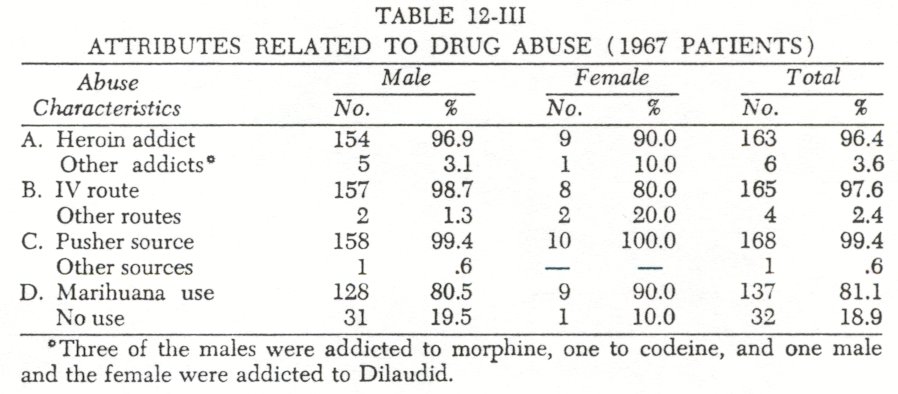
Means of Support
Most legitimate occupations pursued by school dropouts would not provide sufficient income to support drug addiction.In 1961 it was found, however, that 44.1 percent of the addicts of both sexes had managed to maintain some legal occupational role. The number who maintained some legal employment in spite of their addictions increased to66.3 percent in1967.13 No data were available as to what illegal activities provided, the required supplementary funds.
A significant change occurred in how the male addicts supported themselves. In general, the number of addicts who maintained some legal employment increased, and the number of addicts who totally used illegal activities as their means of support decreased. In1961 50.0 percent of the male addicts were unemployed or supporting themselves through illegal activities.By 1967 this proportion had decreased to30.2 percent.
There were no comparable changes for female addicts. Thefemaleaddicts continued to be unemployed or to use illegal activities as their primary means of support. In1961 over90 percent of the female addicts were unemployed or engaged in illegal activities. In1967 a similar pattern occurred.
History of Drug Abuse
The attributes of opiate addiction, for example, drug used and source and method of administering the drug, were not routinely collected at either hospital during1961. They were, however, being collected in1967 and are included here as a partial description of the contemporary Mexican-American addict.
Almost all Mexican-American addicts, regardless of sex, were addicted to heroin(96.4%), which they were injecting intravenously ( 97.6% ) . Almost all ( 99.4% ) were purchasing their drugs, even those legally manufactured, from pushers. In these respects they do not differ from the majority of other addicts in the United States.14 A majority (81.1%) of these Mexican-American addicts also had histories of marihuana smoking which usually preceded their use of narcotics. The pattern of marihuana use is similar to that found among other opiate addicts who reside in large cities outside of the Southern states.15

Onset of Opiate Use
The onset of opiate use occurred early among these biexicanAmerican addicts. The mean age at onset was19.3 years. At least among these169 Mexican-Americans treated during1967, males typically began their opiate use earlier than females.
Years of Opiate Use
At the time of admission for treatment during1967, the169 MexicanAmerican addicts had been using opiates an average of8.8 years. The male addicts had an average of8.9 years of use, while the female addicts had less lengthy histories, with an average of6.3 years:
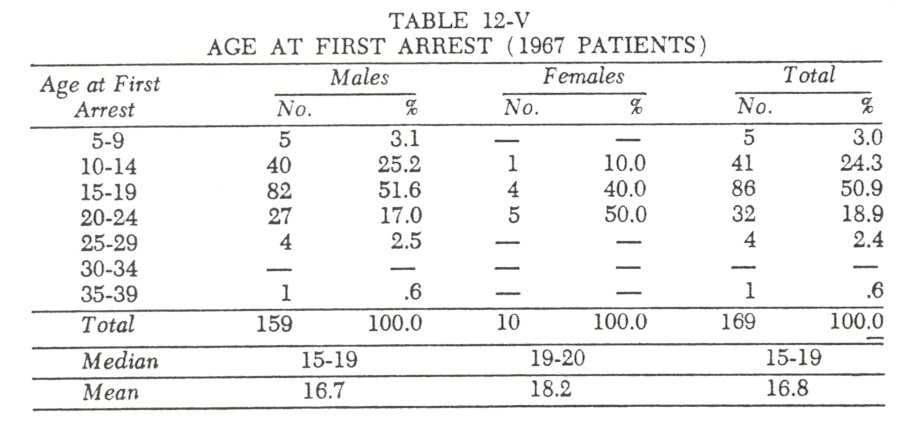
Arrest Histories
Every one of these169 Mexican-American addicts had an arrest history. The average age at which arrest first occurred was16.8 years. Five of the males had been arrested prior to the age of ten. Almost80 percent of all the addicts had been arrested as juveniles or adolescents.
Although all of the female addicts had been arrested, their arrests tended to occur at later ages than did those among the males. Half of the females did not experience their first arrest until after age twenty.
As all of the addicts had been arrested, a comparison between the age of first arrest and the onset of opiate use was possible. The majority of the169 Mexican-American addicts had been arrested prior to opiate use. Of the169, 61.5 percent were arrested before opiate use, while21.3 percent were using opiates before they experienced their first arrest. The remaining17.2 percent were arrested and began opiate use at the same age.16

Admission Characteristics
Hospital Status
During the time periods of this study, two classifications of narcotic addicts were accepted for treatment at the two hospitals: voluntary patients and federal prisoners. The major portion of Mexican-American addicts during1961 ( 55.9% ) were undergoing enforced treatment as federal prisoners.By 1967, however, this had changed significantly, with71.0 percent seeking treatment voluntarily." This increased voluntary utilization of the two federal treatment facilities was true for both male and female addicts.
A majority of the addicts during both years were beingtreated at these facilities for the first time. The proportion of first admissions, however, did significantly change from 1961 to 1967. While only 18.6 percent of all the admissions in 1961 were recidivists, this had increased to 34.3 percent by 1967.18 This measure of recidivism was no higher among the Mexican-Americans ( 34.3% ) than for other addict groups. During the same timeperiod recidivism was as follows for the other groups: Negroes 34.6 percent, Puerto Ricans 38.4 percent, and whites 40.8 percent. Recidivism, at least as measured by the number of readmisions for treatment to one of these federal facilities, appears to have always been greater among male addicts. Readmissions among males during 1961 was 20.5 percent of all admissions, and during 1967 over one-third of all the males treated were recidivists. This compared with female readmissions of only 7.1 percent in 1961 and 20.0 percent in 1967. In neither year was the current hospital admission more than the fifth one for any addict.19

Age at Admission
Mexican-American narcotic addicts of both sexes were found to be young adults. During 1961 75.5 percent ( N=77 ) of the addicts being admitted for treatment were under thirty years of age. While the proportion of addicts under age thirty had significantly decreased by 1987, the majority, 62.7 percent, were still under thirty years of age.20
Comparison of the median age for male and female addicts during both sample years indicated that the age distributions have not significantly changed. The median age group for males and females during 1961 and 1967 are all the same-twenty-five to twenty-nine years. Mean age comparisons, however, did produce one slight change. The mean age for all male admissions increased from 26.3 years in 1961 to 28.2 years in 1967.
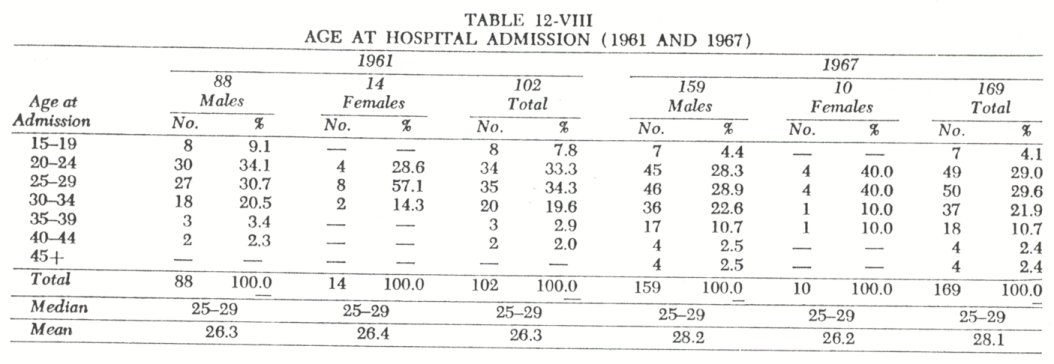
Mexican-Americans and Other Addict Groups
The third area of inquiry designed for this study was to compare the Mexican-American addicts with their contemporaries from other ethnic-cultural groups. For this purpose data were analyzed from case histories of the admissions to the two hospitals during the first six months of 1967.
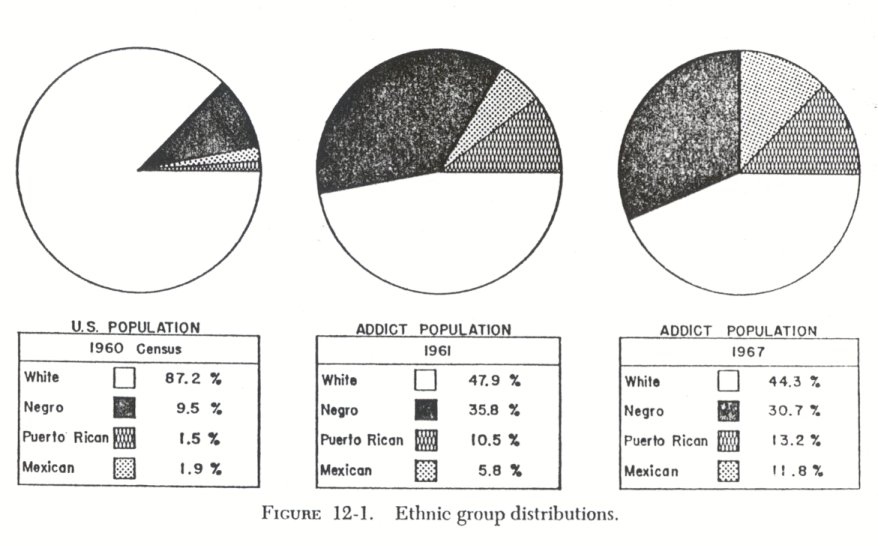
The Ethnic-Cultural Group Distribution
From January through June, 1967, there were 1,438 narcotic addicts admitted to the Lexington and Fort Worth hospitals which could be categorized into four separate ethnic-cultural groups: white, Negro, Puerto Rican, and Mexican-American." Of the four groups, the Mexican-American. group was the smallest, contributing only 11.8 percent of the total admissions.
Two findings relevant to the representation of Mexican Americans within the addict population require elaboration. First, the representation of Mexican-Americans doubled between 1961 and 1967. While this ethniccultural group contributed only 5.8 percent of the total in 1961, it contributed 11.8 percent in 1967. As such, it showed the greatest rate of increase of any of the groups. Second, while the Puerto Ricans were the most overrepresented group in the addicted population during 1961, the Mexican-Americans became the most overrepresented during 1967.
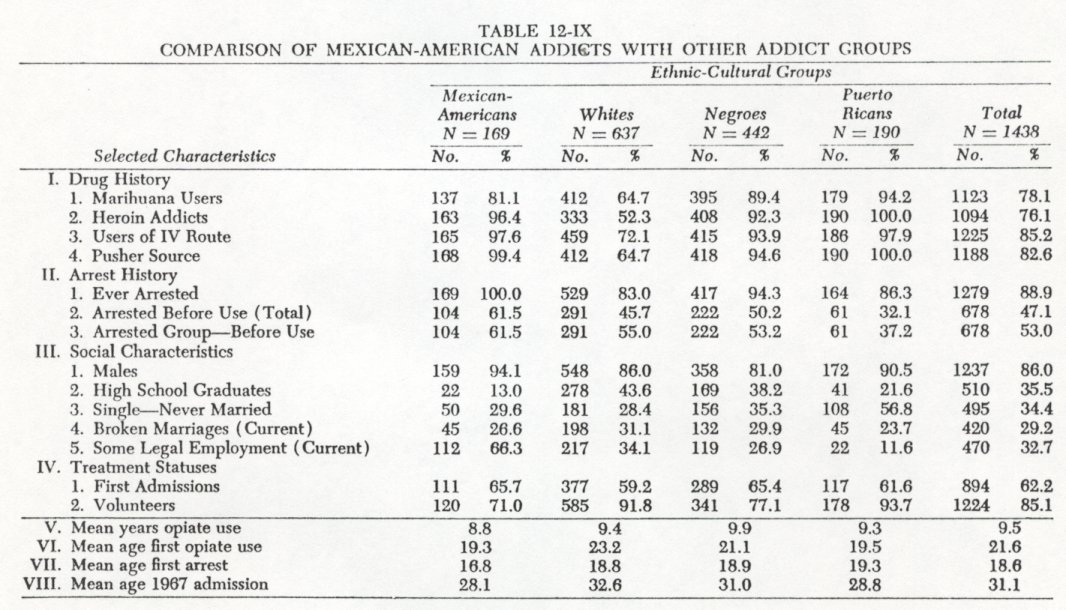
Drug Histories Compared
The groups which share minority group status within the general population are remarkably similar as addict groups. The Mexican-American addicts, for example, do not differ significantly from the Puerto Rican or Negro addicts in their use of marihuana or heroin. Furthermore, all three purchase their drugs from "pushers" and then use the drugs intravenously. As with other addicts from minority groups, the Mexican-Americans, when compared with the white addicts, had more frequently smoked marihuana and were more frequently heroin addicts23. This latter difference is closely associated with the use of psuhers as a source for drugs and use of the intravenous route.24. in brief, Mexican-American, Puerto Rican, and Negro addicts were significantly more often heroin addicts, and they began their drug abuse with marihuana.
Length of Opiate Use
The average length of time since onset of opiate use for these 1,438 addicts was 9.5 years. Although the differences are not significant, MexicanAmericans had been using opiates the shortest period of time, 8.8 years. This compared with 9.3 years for Puerto Ricans, 9.4 years for whites, and 9.9 years for the Negro addicts.
Arrest Histories Compared
While arrest histories are prevalent among all of the addict groups ( 88.9 had been arrested), the prevalence was found to be highest among the Mexican-Americans. All of the MexicanAmerican addicts had an arrest history." By comparison, 94.3 percent of the Negroes, 86.3 percent of the Puerto Ricans, and only 83.0 percent of white addicts had been arrested. In comparing when the first arrest occurred in relation to the onset of opiate use, it was ascertained that of those with arrest histories (N=1,279), a majority, 53.0 percent, had experienced an arrest prior to opiate use. Again, the Mexican-American addicts were found to differ from the other groups. While arrest preceded opiate use for 61.5 percent of the Mexican-Americans, this sequence was true for only 55.0 percent of the whites, 53.2 percent of the Negroes, and 37.2 percent of the Puerto Ricans. The only statistically significant difference was between Mexican-Americans and Puerto Ricans .26
Social Characteristics
Although the differences were not great, male addicts comprised a larger proportion of the Mexican-American group than in any of the other groups. Males constituted 94.1 percent of the Mexican-American group. This compared with 90.5 percent of the Puerto Rican, 86.0 percent of the white, and 81.0 percent of the Negro Mexican-American addicts were more likely to be school dropouts than addicts from other groups. While only 13.0 percent of the Mexican-American addicts were high school graduates, 21.6 percent of the Puerto Ricans, 38.2 percent of the Negroes, and 43.6 percent of the whites had at least completed high school.28
The Mexican-American, white, and Negro addicts were quite similar in their marital status. These three addict groups differ from the Puerto Ricans, who most frequently tend to be single addicts who have never married.
Mexican-American addicts are more likely to maintain some legal occupational role in spite of their addiction than other addicts. Some legal employment was noted for 66.3 percent of the Mexican-Americans but for only 11.6 percent of the Puerto Ricans, 26.9 percent of the Negroes, and 34.1 percent of the whites.=8
Comparison of Recidivism
Mexican-American addicts were not significantly different from other addict groups in the incidence of recidivism. Recidivism, at least as measured by the incidence of treatment readmissions, was found to be high for these addicts; 37.8 percent of all admissions to both hospitals were readmissions. Recidivism was not, however, related to the group membership of the addicts. While readmissions were found to be highest among white addicts (40.8% of all their admissions), this incidence was not significantly different from the 38.4 percent among the Puerto Ricans, 34.6 percent among the Negroes, and 34.3 percent among the MexicanAmericans.
Admission Status Compared
The majority of these addicts ( 85.1% ), regardless of their ethnic-cultural group membership, had voluntarily sought admission for treatment. Of all of the groups, however, the MexicanAmerican addicts had least often sought treatment voluntarily. While only 71.0 percent of the Mexican-Americans were volunteer patients, 93.7 percent of the Puerto Ricans, 91.8 percent of the whites, and 77.1 percent of the Negroes had voluntarily sought treatment.
Mean Age Comparisons
It was possible to compare the age of occurrence of these significant events: first opiate use, first arrest, and hospital admission in 1967. Mexican-American addicts were found to have begun opiate use earlier than any other addict groups, to have been arrested at an earlier age, and to have been younger when admitted for treatment.
The mean age of first opiate use among the Mexican-Americans was 19x3 years. This compared with 19.5 years among the Puerto Ricans, 21.1 years among the Negroes, and 23.2 years among the whites.
The mean age of first arrest for the Mexican-Americans was 16.8 years. The mean age of first arrest for those addicts who were arrested occurred later in the other ethnic-cultural groups. First arrest among whites was 18.8 years, and among Negroes it was almost the same, 18.9 years. First arrest occurred the latest among the Puerto Ricans, 19.3 years.
The mean age at admission in 1967 was 28.1 years for the Mexican-Americans. Puerto Ricans were the next youngest at 28.8 years. The Negro addicts had a mean age of 31.0 years, and the white addicts were the oldest at 32.6 years.
Summary
This study was designed to provide empirical data on MexicanAmerican addicts. With sex as an independent variable, descriptions were provided of the contemporary (1967 ) addicts, statistical comparisons were made to delineate changes which had occurred within this group, and finally, statistical comparisons were made between these Mexican-American addicts and addicts from other ethnic-cultural groups. To accomplish this, data were analyzed from the histories of 1,745 addicts admitted to the Lexington and Fort Worth hospitals during the first six months of 1961 and from the histories of 1,438 addicts admitted during the same time period of 1987.
The following information was found:
1. Female representation among Mexican-American addicts is the smallest among all of the ethnic-culture groups.
2. The incidence of Mexican-American addicts among the hospital admissions doubled between 1961 and 1967 even though the total number of admissions decreased by almost 20 percent.
3. While the incidence of Mexican-American addicts doubled, the increase was only among the males. Female representation in 1967 was less than half that of 1961.
4. The majority of the Mexican-American addicts of both sexes currently reside in Texas. In 1961 California was the largest contributor.
5. Most Mexican-American addicts are school dropouts. The incidence of school dropouts among these addicts is the highest for any of the ethnic-cultural groups studied.
6. Even though they supplement their incomes from illegal sources, a majority of Mexican-American addicts maintained some legal occupational role while addicted.
7. Almost all of the Mexican-Americans were found to be addicted to heroin, which they purchased from illegal sources. They used this drug intravenously.
8. A large majority of the Mexican-Americans had histories of smoking marihuana, and this usually preceded their use of opiates.
9. Onset of opiate use usually occurred during the adolescent years.
10. All of the Mexican-American addicts had been arrested, and this first arrest usually preceded the use of opiates.
11. Mexican-Americans are overrepresented in the addict population to a greater degree than either Negroes or whites, but their overrepresentation is not as great as that of Puerto Ricans. Overrepresentation for whites and Negroes is decreasing, but it is increasing for Mexican-Americans and Puerto Ricans.
Notes:
1. Chambers, C., Moffett, A., and Jones, J.: Demographic factors associated with Negro opiate addiction. International Journal ofthe Addictions, 3(2):329-343, 1988 and Bates W.: Occupational characteristics of Negro addicts. International Journal ofthe Addictions, 3(2):345-350, 1968. See Chapter 11.
2. Ball, J.: Marihuana smoking and the onset of heroin use.British Journal of Criminology,7:408-413, 1967; and Ball, J., and Pabon, D.: Locating and interviewing narcotic addicts in Puerto Rico. Sociology arid SocialResearch, 49:407411, 1965. See Chapter 10.
3. Ball, J., and Lau, M.: The Chinese narcotic addict in the United States. SocialForces, 45:68-?2, 1966. See Chapter14.
4. O'Donnell, J.: Narcotic addiction and crime. SocialProblems, 13(4):374-385, 7966 O'Donnell, J.: The rise and decline of a subculture. SocialProblems, 15(1): 73-84, 1967; and O'Donnell, J., Besteman, K., and Jones, J.: Marital history of narcotics addicts. International Journalof the Addictions, 2(1):21-38, 1967. See Chapter5.
5. For specific examples see Ball, J., Bates, «'., and O'Donnell, J.: Characteristics of hospitalized narcotic addicts.Health, Education and Welfare Indicators, March,1966; Ellinwood, E., Smith, W., and Vaillant, G.: Narcotic addiction in males and females: a comparison. International Journalof the Addictions, 1:33-45, 1966; and Glaser, F.: Narcotic addiction in the pain-prone female patient. Internationaljournal ofthe Addictions, 1:47-59, 1966. See Chapters5 and6.
6. For a complete description of the six groups, see Chapter 1.
7. See Chapter 1, Figure 1-1.
8. Fourteen addicts during1981 and eight during1967 were excluded from this study. Data were missing, making it impossible to ascertain with which ethnic-cultural group to include them.
9. The increase from 69.8 percent in 1981 to 92.2 percent in 1967 is statistically significant: X' - 24.10(?; P = <.001.
10. See Chapter 1, Table 1IV.
11. This decrease is statistically significant: X= - 6.691; P - <.01
12. This increase is statistically significant: Fisher's Exact - 0.00301; P - <.01.
13. This increase is statistically significant: X' - 12.811; P - <.001.
14. Chambers, C. D., Moffett, A. D., and Jones, J. P., op, sit. See Chapters 7 and 11.
15. See Chapters 5 and 7.
16. Data were not available to distinguish which of the events preceded the other for those addicts where both events occurred at the same age.
17. This difference is statistically significant: X' - 19.310; P - <.001.
18. This difference is statistically significant: X' = 7.701; P = <.05.
19. During 1981 the number of admissions for both hospitals ranged from one to twenty seven with 9.8 percent of all those admitted being admitted for the sixth or more time. During 1987 the range was one to nineteen admissions, with only 2.7 percent being admitted for at least the sixth time.
20. This decrease is statistically significant: X' - 4.729; P c <.05.
21. It was not possible to separate the white group into the preferred Southern versus others and the Puerto Ricans into U. S. or Puerto Rican residence. For their probable distributions, however, see Chapter 1, Figure 1-1.
22. The chi-square comparison was X' = 16.514; P - <.001.
23. The chi-square comparison was X2 = 110.113; P - <.001.
24. The chi-square comparisons on the incidence of a pusher source was X2 = 78.131; P = < .001. The close association among heroin use, pusher source and intravenous route is described in Chapter 5, 7 and 9
25. Unfortunately, data were not routinely gathered as to the nature of the arrests. Future studies, of course, should be designed to explore this.
26. The chi-square comparison was X' - 19.731; P - <.001.
27. The difference in sex composition between Mexican-American and Negro addicts is statistically significant: X' - 16.086; P - <.001.
28. Comparing with all the others, the difference is statistically significant: X' = 39.987; P - <.001.
29. Comparing Mexican-Americans with all the others, the difference is statistically significant: X' - 98.196; P - <.001.
| < Prev | Next > |
|---|












